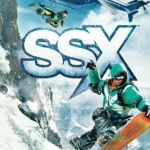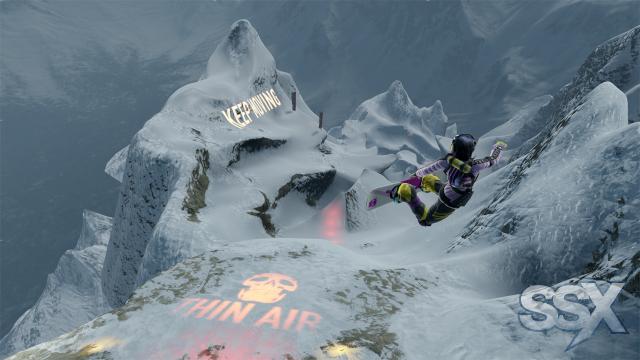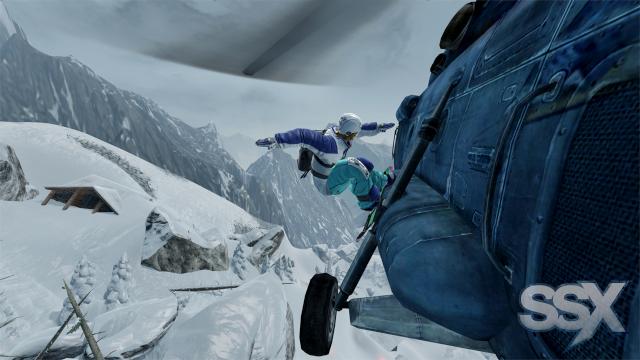
It’s been a fair while, but SSX is back. Throwing yourself down a slippery mountain at breakneck speeds, and leaping across deadly drops while doing a triple backflip and weird board-grabbing leg-splitting trick is normally only the domain of the overly brave or mentally dubious. But EA have given SSX its first outing for quite some time, and surely it’s worth the wait, right?
Well it doesn’t take you long to find out. After leaping from a helicopter at 30,000 feet you’ll be plummeting towards the ground while learning how to spin, flip and do a range of basic moves using the new control system which, like so many recent EA Sports titles, has a heavy focus on the right stick to do all the fancy stuff. It’s a handy crash-course which gives you enough to get started without overburdening you with complicated controls that you’ll forget as soon as it ends. Before long the first mountain range turns up, and that’s when the magic begins.
In the main campaign you’ll start with a single playable character and a few less demanding tasks to break you into the various types of run you’ll be carrying out. Divided into speed, skill and survival (or Race It, Trick It and Survive It to use the actual terms) each mode gives you a different emphasis to focus on while you’re heading down the brilliantly designed slopes. Whether you’re trying to maintain a barely-controllable speed, doing everything you can to chain together a combo of gravity-defying tricks or just trying not to end up a bit dead it’s impossible from minute 1 to ignore just how impressive the mountains are. The developers made a noise about using satellite imaging to give more realistic surroundings, and while that’s clearly done a lot for atmosphere you can’t take anything away from the course designers themselves who have added perfectly positioned trees, pipes, useful snow crests and various other things for you to grind along, leap off and dodge through.
As you progress through the campaign you’ll not only unlock new characters to try out (each with their own strengths) but also new locations, each with their own mountain ranges and hazards. You’ll get a chance to don a wing suit and throw yourself off impossibly long jumps only to glide to a safe landing at the other end. You’ll be ducking in and out of sunlight in the Antarctic keeping a close eye on your temperature, and speeding down Everest with only a small amount of oxygen between a great descent and a nasty blacked-out end. There’s a fair few other risks too, bit with discovery and surprise being half the fun, I won’t ruin too much. These extra challenges turn already nightmarish mountains into panic-driven instinct-powered sessions where you’re quite likely to go the best part of 90 seconds neither blinking nor breathing. And then still probably end up embedded in a tree.

Each character has a massive collection of available boards, tools and outfits to spend your in-game winnings on, with some having extra skills adjusters, some funky glowing or (if you’re lucky) a mystery item which is only available for a short time and doesn’t tell you what you’ve bought until you buy it. Many times you’ll get some standard stuff that would’ve been cheaper, but you’ll also find some real bargains, and some top quality gear available at a huge reduction. It not only lets you customise your experience and increase your chance of success, but also gives you a reason to keep plugging away to win more credits by completing events more effectively. The selection of items of offer is pretty random, so it’s worth checking back before each event in case something neat has turned up recently.
The music selection is pretty much everything you’d expect from a modern SSX title and suits the action perfectly, and yet it’s the execution of the music where the genius lies. Jump of a huge ramp or fling yourself high into the air by some other means and the music muffles down to something you can barely hear, stifled by the concentration needed to hook together a string of 7 different grabs topped off by your character’s Ubermove. The moment you hit the deck, the music surges back into life and the rush to keep control starts again. It’s a very simple system that we’ve seen before in the liked of Burnout Paradise, but it’s massively effective and adds a good amount of drama to an already tense event.
When you come to see what you can do with friends there’s some slight disappointment balanced out by some brilliant online features. What you can’t do, which in my eyes is a huge shame, is compete directly against your friends or other randoms from the Interweb. There’s no option to jump onto a mountain and race against 3 others, and no ability to drop yourself at the top of a mountain and trick our own way down while others around you are doing the same thing. However, what we’ve got available does make up for it and anyone who got hooked in by the Autolog feature in recent Need for Speed titles will feel instantly at home with RiderNet – SSX’s very own hey-look-your-friends-are-better-than-you system.
Built into a mode away from the campaign that allows you to jump on any slope with any rider, even without the RiderNet it’s a great way to earn a few in-game credits by beating the medal scores or times set in place by default. You can even just use it to explore the mountains, trying to find new routes, bigger jumps or just tricky places to drop your geotags (more on that later). But of course add the RiderNet into the mix and your friends make life a lot more interesting. Each course tracks every high score from every friend, and you’ll be offered recommendations of events to try, told who has tried an event that you’ve yet to run and which annoying git has been up all night beating every last one of your greatest achievements. There are also global events constantly taking place, competitions open to everyone to enter where the prizes are dished out in varying quantities depending on where you end up in the wordwide leaderboard. The trouble is, there are a hell of a lot of very good SSX players out there, and finishing high enough to even win a prize is a big ask; you’ll need to get a bit of practice, that’s for sure.

As for the geotags mentioned earlier, they’re a great diversion when you’re bored of the usual point-chasing. Provided you have one equipped, you can rewind the action at any point and drop a tag where you currently are, whether that’s half way down a ravine, up a tree or 100 feet in the air. These then show up to other players as hovering coloured icons that gain value the longer they go uncollected, so drop one in a really awkward spot and your tag will soon become worth quite a bit and something other gamers will be fighting to try and grab hold of. It’s a great feature that doesn’t need to be there, but definitely adds something a little extra.
So SSX is back. The old magic is still there, the joy of turning your frantic button mashing into carefully considered sequences of precise tricks is still there, and the new generation has brought some great visuals and online play to breathe life into a fondly remembered old dog. If you thought people would only like SSX through rose-tinted glasses, then you were wrong. This is really good fun and despite the occasionally frustrating difficulty leaps it should keep you busy for quite some time.
Reviewed on PS3


Leave a Reply